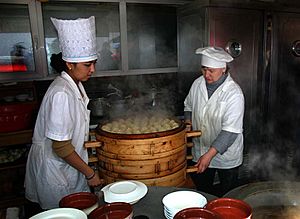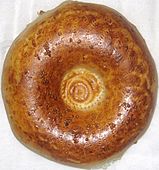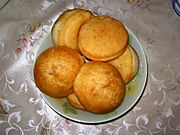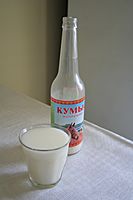Kazakh cuisine facts for kids
Kazakhstan is a large country in Central Asia, and its traditional food, called Kazakh cuisine, is very special! For hundreds of years, Kazakh people were nomads. This means they traveled with their animals like sheep, camels, and horses. These animals were super important for everything: travel, clothes, and especially food!
Because they were always on the move, Kazakh cooking methods focused on keeping food fresh for a long time. They would salt and dry meat. They also preferred sour milk products because they lasted longer without refrigeration. Meat, especially mutton (sheep meat) and horse meat, is the main ingredient in most Kazakh dishes. Traditional cooking often involves boiling large pieces of meat.
Contents
Kazakh Cuisine: A Taste of Tradition
Kazakh food is mostly made from four kinds of animals: horses, camels, cows, and sheep. Horse and camel meat are often eaten during special celebrations. Sheep and cow meat are more common for everyday meals.
What Do Kazakhs Eat?
Meat Dishes You'll Love
The most famous Kazakh dish is Et or Besbarmaq. It means "five fingers" because people traditionally eat it with their hands! This dish is made with boiled horse or mutton meat. The host cuts the meat and serves it to guests, starting with the most important person. Besbarmaq is usually eaten with boiled pasta sheets and a meat broth called sorpa. It's served in special Kazakh bowls called kese.
Another popular meat dish is Quwyrdaq. This is made from roasted horse, sheep, or cow organs like heart, liver, and kidneys. It's diced and served with onions and peppers.
Other special meat treats include:
- Qazy: A horse meat sausage that used to be a luxury.
- Shuzhyq: Another type of horse meat sausage.
- Zhal: Smoked fat from a horse's neck, served to very special guests.
- Zhaya: Salted and smoked meat from a horse's hip.
Palaw is a dish made from meat fried with carrots, onions, or garlic, then cooked with rice. It's similar to pilaf.
Qiymay is a sausage made by stuffing intestines with ground meat, fat, blood, garlic, salt, and pepper. It's made in the fall and winter. Zhawbüyrek is like a kebab, with small pieces of meat roasted over a fire. It's popular with hunters and travelers.
Ülpershek is a dish made from a horse's heart, aorta, and fat, cooked in a kettle. It's often shared between sisters-in-law to show unity.
Miypalaw is a dish made from sheep's brain, mixed with marrow, meat pieces, salted fat, and garlic. It's often served to honored guests. Aqshelek is a large camel bone given to children after a camel is slaughtered and cooked.
Sür et is salted horsemeat that is smoked over special wood like elm or juniper.
Milk Products: A Staple
Milk products are a big part of Kazakh food.
- Süt is simply boiled milk.
- Qaymaq is sour cream made from boiled milk, sometimes served with tea.
- Sary may is butter made from aged milk.
- Qurt is a dried, salty cheese made by pressing thick sour cream. It's often dried until it's white and hard.
- Irimshik is a type of cottage cheese made in the spring from boiled, unskimmed milk and sour cream.
Other milk products include Süzbe and Qatyq, which are strained and thickened sour milk. Qoryqtyq is a herdsman's food, made from thickened milk out on the steppe. Ayran is a sour milk drink enjoyed in both winter and summer.
Breads and Pastries
When flour became available, new dishes appeared:
- Bawyrsaq: These are delicious fried dough balls.
- Shelpek: A flat cake also made by frying dough.
- Mänti: A very popular dish! These are dumplings filled with spiced ground lamb or beef, cooked in a steamer, and served with butter, sour cream, or onion sauce.
- Nan: A traditional bread baked in a special oven called a tandyr. It's popular in cities along the ancient Silk Road.
Other sweet treats include Quymaq, Qattama, and Oyma, which are flat puff cakes fried in oil and covered in cream. Shek-shek is another sweet pastry.
Delicious Drinks
Traditional drinks are often made from fermented milk:
- Qymyz: Fermented mare's (female horse's) milk.
- Shubat: Fermented camel's milk.
- Ayran: Fermented cow's milk.
These drinks were traditionally served with the main meal. Meals often end with qymyz and then tea. In the summer, shubat is a favorite drink for the Adai Kazakhs.
Black tea came to Kazakhstan from China along the Silk Road. Today, tea is super popular and is served with almost every meal. Kazakh tea is usually strong black tea with milk or cream. Kazakhs drink a lot of tea, about 1.2 kilograms per person each year! The tea ceremony is a special ritual called dastarqan, showing great care for guests. It's traditional not to fill the tea cup (kese) to the brim. The less tea poured, the more respect is shown, as the host will keep refilling it with hot tea.
Sweet Treats
The most common traditional sweets are Bawyrsaq, Shelpek, Shek-shek, and Zhent. These are easy to make, even when traveling, and are always a part of celebrations.
How Nomads Cooked
Because Kazakhs were nomads, they had very little cooking equipment. They had to carry everything with them! The most important tool was the iron kazan, a large pot used for cooking almost everything, from pilaf to soups, and even flatbreads.
The host of a meal traditionally cuts the meat and gives the best pieces to honored guests or children. Sometimes, the most honored guest receives a cooked ram's head as a special sign of respect. Guests are always given the best spot and a warm welcome.
Kazakhs traditionally eat at a low table called a dastarqan. They also like to use beautiful dishes. Qymyz is served in wide bowls decorated with silver, and meat is often on large platters. Tea is made in fancy teapots and served in lovely cups. Even dough was made in small wooden basins, and wooden spoons were carefully kept in special cases, showing how important food and its traditions are in Kazakhstan.
See also
 In Spanish: Gastronomía de Kazajistán para niños
In Spanish: Gastronomía de Kazajistán para niños












